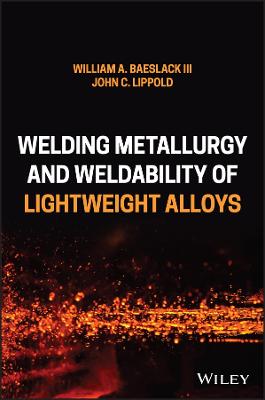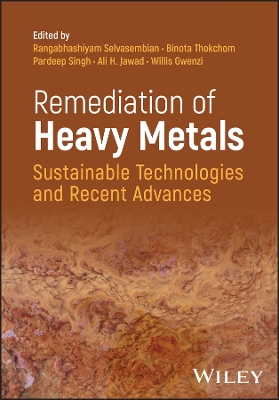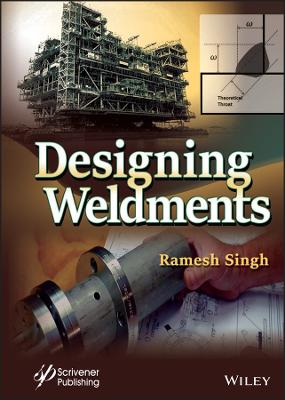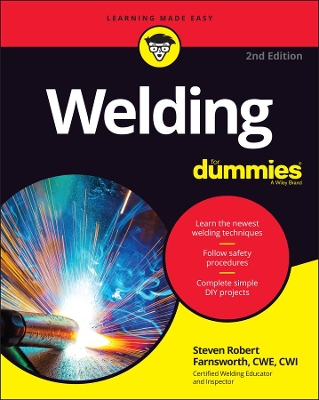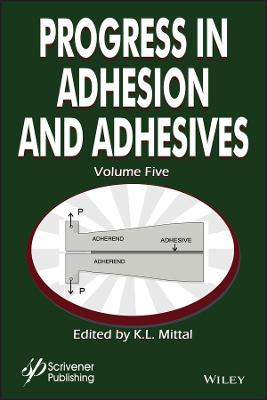Welding Metallurgy and Weldability
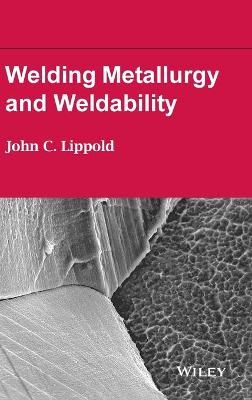 -15%
portes grátis
-15%
portes grátis
Welding Metallurgy and Weldability
Lippold, John C.
John Wiley & Sons Inc
01/2015
432
Dura
Inglês
9781118230701
15 a 20 dias
714
Descrição não disponível.
Preface xiii
Author Biography xvi
1 Introduction 1
1.1 Fabrication-Related Defects 5
1.2 Service-Related Defects 6
1.3 Defect Prevention and Control 7
References 8
2 Welding Metallurgy Principles 9
2.1 Introduction 9
2.2 Regions of a Fusion Weld 10
2.3 Fusion Zone 13
2.3.1 Solidification of Metals 15
2.3.1.1 Solidification Parameters 15
2.3.1.2 Solidification Nucleation 17
2.3.1.3 Solidification Modes 19
2.3.1.4 Interface Stability 22
2.3.2 Macroscopic Aspects of Weld Solidification 24
2.3.2.1 Effect of Travel Speed and Temperature Gradient 27
2.3.3 Microscopic Aspects of Weld Solidification 30
2.3.3.1 Solidification Subgrain Boundaries (SSGB) 32
2.3.3.2 Solidification Grain Boundaries (SGB) 33
2.3.3.3 Migrated Grain Boundaries (MGB) 34
2.3.4 Solute Redistribution 34
2.3.4.1 Macroscopic Solidification 35
2.3.4.2 Microscopic Solidification 37
2.3.5 Examples of Fusion Zone Microstructures 40
2.3.6 Transition Zone (TZ) 43
2.4 Unmixed Zone (UMZ) 45
2.5 Partially Melted Zone (PMZ) 48
2.5.1 Penetration Mechanism 50
2.5.2 Segregation Mechanism 53
2.5.2.1 Gibbsian Segregation 56
2.5.2.2 Grain Boundary Sweeping 56
2.5.2.3 Pipeline Diffusion 57
2.5.2.4 Grain Boundary Wetting 58
2.5.3 Examples of PMZ formation 58
2.6 Heat Affected Zone (HAZ) 60
2.6.1 Recrystallization and Grain Growth 61
2.6.2 Allotropic Phase Transformations 63
2.6.3 Precipitation Reactions 66
2.6.4 Examples of HAZ Microstructure 69
2.7 Solid-State Welding 70
2.7.1 Friction Stir Welding 72
2.7.2 Diffusion Welding 76
2.7.3 Explosion Welding 77
2.7.4 Ultrasonic Welding 79
References 81
3 Hot Cracking 84
3.1 Introduction 84
3.2 Weld Solidification Cracking 85
3.2.1 Theories of Weld Solidification Cracking 85
3.2.1.1 Shrinkage-Brittleness Theory 86
3.2.1.2 Strain Theory 87
3.2.1.3 Generalized Theory 88
3.2.1.4 Modified Generalized Theory 89
3.2.1.5 Technological Strength Theory 90
3.2.1.6 Commentary on Solidification Cracking Theories 91
3.2.2 Predictions of Elemental Effects 94
3.2.3 The BTR and Solidification Cracking Temperature Range 97
3.2.4 Factors that Influence Weld Solidification Cracking 102
3.2.4.1 Composition Control 102
3.2.4.2 Grain Boundary Liquid Films 109
3.2.4.3 Effect of Restraint 110
3.2.5 Identifying Weld Solidification Cracking 112
3.2.6 Preventing Weld Solidification Cracking 116
3.3 Liquation Cracking 119
3.3.1 HAZ Liquation Cracking 119
3.3.2 weld metal Liquation Cracking 122
3.3.3 Variables that Influence Susceptibility to Liquation Cracking 123
3.3.3.1 Composition 123
3.3.3.2 Grain Size 124
3.3.3.3 Base Metal Heat Treatment 125
3.3.3.4 Weld Heat Input and Filler Metal Selection 125
3.3.4 Identifying HAZ and weld metal Liquation Cracks 126
3.3.5 Preventing Liquation Cracking 127
References 128
4 Solid-State Cracking 130
4.1 Introduction 130
4.2 Ductility-dip Cracking 130
4.2.1 Proposed Mechanisms 133
4.2.2 Summary of Factors That Influence DDC 139
4.2.3 Quantifying Ductility-Dip Cracking 143
4.2.4 Identifying Ductility-Dip Cracks 145
4.2.5 Preventing DDC 147
4.3 Reheat Cracking 149
4.3.1 Reheat Cracking in Low-Alloy Steels 150
4.3.2 Reheat Cracking in Stainless Steels 155
4.3.3 Underclad Cracking 158
4.3.4 Relaxation Cracking 160
4.3.5 Identifying Reheat Cracking 161
4.3.6 Quantifying Reheat Cracking Susceptibility 163
4.3.7 Preventing Reheat Cracking 166
4.4 Strain-age Cracking 168
4.4.1 Mechanism for Strain-age Cracking 171
4.4.2 Factors That Influence SAC Susceptibility 178
4.4.2.1 Composition 178
4.4.2.2 Grain Size 179
4.4.2.3 Residual Stress and Restraint 179
4.4.2.4 Welding Procedure 180
4.4.2.5 Effect of PWHT 181
4.4.3 Quantifying Susceptibility to Strain-age Cracking 182
4.4.4 Identifying Strain-age Cracking 189
4.4.5 Preventing Strain-age Cracking 189
4.5 Lamellar Cracking 190
4.5.1 Mechanism of Lamellar Cracking 191
4.5.2 Quantifying Lamellar Cracking 195
4.5.3 Identifying Lamellar Cracking 197
4.5.4 Preventing Lamellar Cracking 198
4.6 Copper Contamination Cracking 201
4.6.1 Mechanism for Copper Contamination Cracking 201
4.6.2 Quantifying Copper Contamination Cracking 203
4.6.3 Identifying Copper Contamination Cracking 205
4.6.4 Preventing Copper Contamination Cracking 205
References 207
5 Hydrogen-Induced Cracking 213
5.1 Introduction 213
5.2 Hydrogen Embrittlement Theories 214
5.2.1 Planar Pressure Theory 216
5.2.2 Surface Adsorption Theory 217
5.2.3 Decohesion Theory 217
5.2.4 Hydrogen-Enhanced Localized Plasticity Theory 218
5.2.5 Beachem's Stress Intensity Model 219
5.3 Factors That Influence HIC 221
5.3.1 Hydrogen in Welds 221
5.3.2 Effect of Microstructure 224
5.3.3 Restraint 228
5.3.4 Temperature 230
5.4 Quantifying Susceptibility to HIC 230
5.4.1 Jominy End Quench Method 231
5.4.2 Controlled Thermal Severity Test 234
5.4.3 The Y-Groove (Tekken) Test 235
5.4.4 Gapped Bead-on-Plate Test 236
5.4.5 The Implant Test 237
5.4.6 Tensile Restraint Cracking Test 243
5.4.7 Augmented Strain Cracking Test 244
5.5 Identifying HIC 245
5.6 Preventing HIC 247
5.6.1 CE Method 251
5.6.2 AWS Method 254
References 259
6 Corrosion 263
6.1 Introduction 263
6.2 Forms of Corrosion 264
6.2.1 General Corrosion 264
6.2.2 Galvanic Corrosion 265
6.2.3 Crevice Corrosion 267
6.2.4 Selective Leaching 268
6.2.5 Erosion Corrosion 268
6.2.6 Pitting 268
6.2.7 Intergranular Corrosion 271
6.2.7.1 Preventing Sensitization 275
6.2.7.2 Knifeline Attack 276
6.2.7.3 Low-Temperature Sensitization 276
6.2.8 Stress Corrosion Cracking 277
6.2.9 Microbiologically Induced Corrosion 280
6.3 Corrosion Testing 282
6.3.1 Atmospheric Corrosion Tests 282
6.3.2 Immersion Tests 282
6.3.3 Electrochemical Tests 284
References 286
7 Fracture and Fatigue 288
7.1 Introduction 288
7.2 Fracture 290
7.3 Quantifying Fracture Toughness 293
7.4 Fatigue 297
7.5 Quantifying Fatigue Behavior 305
7.6 Identifying Fatigue Cracking 306
7.6.1 Beach Marks 307
7.6.2 River Lines 307
7.6.3 Fatigue Striations 307
7.7 Avoiding Fatigue Failures 309
References 310
8 Failure Analysis 311
8.1 Introduction 311
8.2 Fractography 312
8.2.1 History of Fractography 312
8.2.2 The SEM 313
8.2.3 Fracture Modes 315
8.2.4 Fractography of Weld Failures 320
8.2.4.1 Solidification Cracking 320
8.2.4.2 Liquation Cracking 323
8.2.4.3 Ductility-Dip Cracking 326
8.2.4.4 Reheat Cracking 326
8.2.4.5 Strain-Age Cracking 331
8.2.4.6 Hydrogen-Induced Cracking 332
8.3 An Engineer's Guide to Failure Analysis 333
8.3.1 Site Visit 334
8.3.2 Collect Background Information 335
8.3.3 Sample Removal and Testing Protocol 336
8.3.4 Sample Removal, Cleaning, and Storage 336
8.3.5 Chemical Analysis 336
8.3.6 Macroscopic Analysis 337
8.3.7 Selection of Samples for Microscopic Analysis 338
8.3.8 Selection of Analytical Techniques 338
8.3.9 Mechanical Testing 339
8.3.10 Simulative Testing 339
8.3.11 Nondestructive Evaluation Techniques 340
8.3.12 Structural Integrity Assessment 340
8.3.13 Consultation with Experts 340
8.3.14 Final Reporting 340
8.3.15 Expert Testimony in Support of Litigation 341
References 342
9 Weldability Testing 343
9.1 Introduction 343
9.2 Types of Weldability Test Techniques 344
9.3 The Varestraint Test 345
9.3.1 Technique for Quantifying Weld Solidification Cracking 346
9.3.2 Technique for Quantifying HAZ Liquation Cracking 350
9.4 The Cast Pin Tear Test 354
9.5 The Hot Ductility Test 357
9.6 The Strain-to-Fracture Test 362
9.7 Reheat Cracking Test 363
9.8 Implant Test for HAZ Hydrogen-Induced Cracking 366
9.9 Gapped Bead-on-Plate Test for Weld Metal HIC 367
9.10 O ther Weldability Tests 370
References 371
Appendix A 372
Appendix B 374
Appendix C 383
Appendix D 388
Index 396
Author Biography xvi
1 Introduction 1
1.1 Fabrication-Related Defects 5
1.2 Service-Related Defects 6
1.3 Defect Prevention and Control 7
References 8
2 Welding Metallurgy Principles 9
2.1 Introduction 9
2.2 Regions of a Fusion Weld 10
2.3 Fusion Zone 13
2.3.1 Solidification of Metals 15
2.3.1.1 Solidification Parameters 15
2.3.1.2 Solidification Nucleation 17
2.3.1.3 Solidification Modes 19
2.3.1.4 Interface Stability 22
2.3.2 Macroscopic Aspects of Weld Solidification 24
2.3.2.1 Effect of Travel Speed and Temperature Gradient 27
2.3.3 Microscopic Aspects of Weld Solidification 30
2.3.3.1 Solidification Subgrain Boundaries (SSGB) 32
2.3.3.2 Solidification Grain Boundaries (SGB) 33
2.3.3.3 Migrated Grain Boundaries (MGB) 34
2.3.4 Solute Redistribution 34
2.3.4.1 Macroscopic Solidification 35
2.3.4.2 Microscopic Solidification 37
2.3.5 Examples of Fusion Zone Microstructures 40
2.3.6 Transition Zone (TZ) 43
2.4 Unmixed Zone (UMZ) 45
2.5 Partially Melted Zone (PMZ) 48
2.5.1 Penetration Mechanism 50
2.5.2 Segregation Mechanism 53
2.5.2.1 Gibbsian Segregation 56
2.5.2.2 Grain Boundary Sweeping 56
2.5.2.3 Pipeline Diffusion 57
2.5.2.4 Grain Boundary Wetting 58
2.5.3 Examples of PMZ formation 58
2.6 Heat Affected Zone (HAZ) 60
2.6.1 Recrystallization and Grain Growth 61
2.6.2 Allotropic Phase Transformations 63
2.6.3 Precipitation Reactions 66
2.6.4 Examples of HAZ Microstructure 69
2.7 Solid-State Welding 70
2.7.1 Friction Stir Welding 72
2.7.2 Diffusion Welding 76
2.7.3 Explosion Welding 77
2.7.4 Ultrasonic Welding 79
References 81
3 Hot Cracking 84
3.1 Introduction 84
3.2 Weld Solidification Cracking 85
3.2.1 Theories of Weld Solidification Cracking 85
3.2.1.1 Shrinkage-Brittleness Theory 86
3.2.1.2 Strain Theory 87
3.2.1.3 Generalized Theory 88
3.2.1.4 Modified Generalized Theory 89
3.2.1.5 Technological Strength Theory 90
3.2.1.6 Commentary on Solidification Cracking Theories 91
3.2.2 Predictions of Elemental Effects 94
3.2.3 The BTR and Solidification Cracking Temperature Range 97
3.2.4 Factors that Influence Weld Solidification Cracking 102
3.2.4.1 Composition Control 102
3.2.4.2 Grain Boundary Liquid Films 109
3.2.4.3 Effect of Restraint 110
3.2.5 Identifying Weld Solidification Cracking 112
3.2.6 Preventing Weld Solidification Cracking 116
3.3 Liquation Cracking 119
3.3.1 HAZ Liquation Cracking 119
3.3.2 weld metal Liquation Cracking 122
3.3.3 Variables that Influence Susceptibility to Liquation Cracking 123
3.3.3.1 Composition 123
3.3.3.2 Grain Size 124
3.3.3.3 Base Metal Heat Treatment 125
3.3.3.4 Weld Heat Input and Filler Metal Selection 125
3.3.4 Identifying HAZ and weld metal Liquation Cracks 126
3.3.5 Preventing Liquation Cracking 127
References 128
4 Solid-State Cracking 130
4.1 Introduction 130
4.2 Ductility-dip Cracking 130
4.2.1 Proposed Mechanisms 133
4.2.2 Summary of Factors That Influence DDC 139
4.2.3 Quantifying Ductility-Dip Cracking 143
4.2.4 Identifying Ductility-Dip Cracks 145
4.2.5 Preventing DDC 147
4.3 Reheat Cracking 149
4.3.1 Reheat Cracking in Low-Alloy Steels 150
4.3.2 Reheat Cracking in Stainless Steels 155
4.3.3 Underclad Cracking 158
4.3.4 Relaxation Cracking 160
4.3.5 Identifying Reheat Cracking 161
4.3.6 Quantifying Reheat Cracking Susceptibility 163
4.3.7 Preventing Reheat Cracking 166
4.4 Strain-age Cracking 168
4.4.1 Mechanism for Strain-age Cracking 171
4.4.2 Factors That Influence SAC Susceptibility 178
4.4.2.1 Composition 178
4.4.2.2 Grain Size 179
4.4.2.3 Residual Stress and Restraint 179
4.4.2.4 Welding Procedure 180
4.4.2.5 Effect of PWHT 181
4.4.3 Quantifying Susceptibility to Strain-age Cracking 182
4.4.4 Identifying Strain-age Cracking 189
4.4.5 Preventing Strain-age Cracking 189
4.5 Lamellar Cracking 190
4.5.1 Mechanism of Lamellar Cracking 191
4.5.2 Quantifying Lamellar Cracking 195
4.5.3 Identifying Lamellar Cracking 197
4.5.4 Preventing Lamellar Cracking 198
4.6 Copper Contamination Cracking 201
4.6.1 Mechanism for Copper Contamination Cracking 201
4.6.2 Quantifying Copper Contamination Cracking 203
4.6.3 Identifying Copper Contamination Cracking 205
4.6.4 Preventing Copper Contamination Cracking 205
References 207
5 Hydrogen-Induced Cracking 213
5.1 Introduction 213
5.2 Hydrogen Embrittlement Theories 214
5.2.1 Planar Pressure Theory 216
5.2.2 Surface Adsorption Theory 217
5.2.3 Decohesion Theory 217
5.2.4 Hydrogen-Enhanced Localized Plasticity Theory 218
5.2.5 Beachem's Stress Intensity Model 219
5.3 Factors That Influence HIC 221
5.3.1 Hydrogen in Welds 221
5.3.2 Effect of Microstructure 224
5.3.3 Restraint 228
5.3.4 Temperature 230
5.4 Quantifying Susceptibility to HIC 230
5.4.1 Jominy End Quench Method 231
5.4.2 Controlled Thermal Severity Test 234
5.4.3 The Y-Groove (Tekken) Test 235
5.4.4 Gapped Bead-on-Plate Test 236
5.4.5 The Implant Test 237
5.4.6 Tensile Restraint Cracking Test 243
5.4.7 Augmented Strain Cracking Test 244
5.5 Identifying HIC 245
5.6 Preventing HIC 247
5.6.1 CE Method 251
5.6.2 AWS Method 254
References 259
6 Corrosion 263
6.1 Introduction 263
6.2 Forms of Corrosion 264
6.2.1 General Corrosion 264
6.2.2 Galvanic Corrosion 265
6.2.3 Crevice Corrosion 267
6.2.4 Selective Leaching 268
6.2.5 Erosion Corrosion 268
6.2.6 Pitting 268
6.2.7 Intergranular Corrosion 271
6.2.7.1 Preventing Sensitization 275
6.2.7.2 Knifeline Attack 276
6.2.7.3 Low-Temperature Sensitization 276
6.2.8 Stress Corrosion Cracking 277
6.2.9 Microbiologically Induced Corrosion 280
6.3 Corrosion Testing 282
6.3.1 Atmospheric Corrosion Tests 282
6.3.2 Immersion Tests 282
6.3.3 Electrochemical Tests 284
References 286
7 Fracture and Fatigue 288
7.1 Introduction 288
7.2 Fracture 290
7.3 Quantifying Fracture Toughness 293
7.4 Fatigue 297
7.5 Quantifying Fatigue Behavior 305
7.6 Identifying Fatigue Cracking 306
7.6.1 Beach Marks 307
7.6.2 River Lines 307
7.6.3 Fatigue Striations 307
7.7 Avoiding Fatigue Failures 309
References 310
8 Failure Analysis 311
8.1 Introduction 311
8.2 Fractography 312
8.2.1 History of Fractography 312
8.2.2 The SEM 313
8.2.3 Fracture Modes 315
8.2.4 Fractography of Weld Failures 320
8.2.4.1 Solidification Cracking 320
8.2.4.2 Liquation Cracking 323
8.2.4.3 Ductility-Dip Cracking 326
8.2.4.4 Reheat Cracking 326
8.2.4.5 Strain-Age Cracking 331
8.2.4.6 Hydrogen-Induced Cracking 332
8.3 An Engineer's Guide to Failure Analysis 333
8.3.1 Site Visit 334
8.3.2 Collect Background Information 335
8.3.3 Sample Removal and Testing Protocol 336
8.3.4 Sample Removal, Cleaning, and Storage 336
8.3.5 Chemical Analysis 336
8.3.6 Macroscopic Analysis 337
8.3.7 Selection of Samples for Microscopic Analysis 338
8.3.8 Selection of Analytical Techniques 338
8.3.9 Mechanical Testing 339
8.3.10 Simulative Testing 339
8.3.11 Nondestructive Evaluation Techniques 340
8.3.12 Structural Integrity Assessment 340
8.3.13 Consultation with Experts 340
8.3.14 Final Reporting 340
8.3.15 Expert Testimony in Support of Litigation 341
References 342
9 Weldability Testing 343
9.1 Introduction 343
9.2 Types of Weldability Test Techniques 344
9.3 The Varestraint Test 345
9.3.1 Technique for Quantifying Weld Solidification Cracking 346
9.3.2 Technique for Quantifying HAZ Liquation Cracking 350
9.4 The Cast Pin Tear Test 354
9.5 The Hot Ductility Test 357
9.6 The Strain-to-Fracture Test 362
9.7 Reheat Cracking Test 363
9.8 Implant Test for HAZ Hydrogen-Induced Cracking 366
9.9 Gapped Bead-on-Plate Test for Weld Metal HIC 367
9.10 O ther Weldability Tests 370
References 371
Appendix A 372
Appendix B 374
Appendix C 383
Appendix D 388
Index 396
Este título pertence ao(s) assunto(s) indicados(s). Para ver outros títulos clique no assunto desejado.
Weldability; fabrication-related defects; service-related defects; defect prevention; defect control; welding metallurgy principles; fusion weld; fusion zone; metal solidification; solidification parameters; solidification nucleation; solidification modes; interface stability; weld solidification; macroscopic welding; travel speed; temperature gradient; solidification subgrain boundaries; solidification grain boundaries; migrated grain boundaries; solute redistribution; macroscopic solidification; microscopic solidification; fusion zone microstructures; transition zone; unmixed zone; partially melted zone; penetration mechanism; segregation mechanism; Gibbsian mechanism; grain boundary sweeping; weldability testing; cast pin tear test; chemical analysis; mechanical testing; simulative testing; macroscopic analysis; hydrogen induced cracking; strain age cracking; reheat cracking; liquidation cracking; solid state cracking; Ductility Dip Cracking; weld failures; fracture and fatigue; fatigue failures; corrosion; knifeline attack; stress corrosion cracking; galvanic corrosion; crevice corrosion; selective leaching; erosion corrosion; pitting; hydrogen induced cracking; planar pressure theory; surface adsorption theory; decohesion theory; HELP theory; low alloy steels; stainless steels
Preface xiii
Author Biography xvi
1 Introduction 1
1.1 Fabrication-Related Defects 5
1.2 Service-Related Defects 6
1.3 Defect Prevention and Control 7
References 8
2 Welding Metallurgy Principles 9
2.1 Introduction 9
2.2 Regions of a Fusion Weld 10
2.3 Fusion Zone 13
2.3.1 Solidification of Metals 15
2.3.1.1 Solidification Parameters 15
2.3.1.2 Solidification Nucleation 17
2.3.1.3 Solidification Modes 19
2.3.1.4 Interface Stability 22
2.3.2 Macroscopic Aspects of Weld Solidification 24
2.3.2.1 Effect of Travel Speed and Temperature Gradient 27
2.3.3 Microscopic Aspects of Weld Solidification 30
2.3.3.1 Solidification Subgrain Boundaries (SSGB) 32
2.3.3.2 Solidification Grain Boundaries (SGB) 33
2.3.3.3 Migrated Grain Boundaries (MGB) 34
2.3.4 Solute Redistribution 34
2.3.4.1 Macroscopic Solidification 35
2.3.4.2 Microscopic Solidification 37
2.3.5 Examples of Fusion Zone Microstructures 40
2.3.6 Transition Zone (TZ) 43
2.4 Unmixed Zone (UMZ) 45
2.5 Partially Melted Zone (PMZ) 48
2.5.1 Penetration Mechanism 50
2.5.2 Segregation Mechanism 53
2.5.2.1 Gibbsian Segregation 56
2.5.2.2 Grain Boundary Sweeping 56
2.5.2.3 Pipeline Diffusion 57
2.5.2.4 Grain Boundary Wetting 58
2.5.3 Examples of PMZ formation 58
2.6 Heat Affected Zone (HAZ) 60
2.6.1 Recrystallization and Grain Growth 61
2.6.2 Allotropic Phase Transformations 63
2.6.3 Precipitation Reactions 66
2.6.4 Examples of HAZ Microstructure 69
2.7 Solid-State Welding 70
2.7.1 Friction Stir Welding 72
2.7.2 Diffusion Welding 76
2.7.3 Explosion Welding 77
2.7.4 Ultrasonic Welding 79
References 81
3 Hot Cracking 84
3.1 Introduction 84
3.2 Weld Solidification Cracking 85
3.2.1 Theories of Weld Solidification Cracking 85
3.2.1.1 Shrinkage-Brittleness Theory 86
3.2.1.2 Strain Theory 87
3.2.1.3 Generalized Theory 88
3.2.1.4 Modified Generalized Theory 89
3.2.1.5 Technological Strength Theory 90
3.2.1.6 Commentary on Solidification Cracking Theories 91
3.2.2 Predictions of Elemental Effects 94
3.2.3 The BTR and Solidification Cracking Temperature Range 97
3.2.4 Factors that Influence Weld Solidification Cracking 102
3.2.4.1 Composition Control 102
3.2.4.2 Grain Boundary Liquid Films 109
3.2.4.3 Effect of Restraint 110
3.2.5 Identifying Weld Solidification Cracking 112
3.2.6 Preventing Weld Solidification Cracking 116
3.3 Liquation Cracking 119
3.3.1 HAZ Liquation Cracking 119
3.3.2 weld metal Liquation Cracking 122
3.3.3 Variables that Influence Susceptibility to Liquation Cracking 123
3.3.3.1 Composition 123
3.3.3.2 Grain Size 124
3.3.3.3 Base Metal Heat Treatment 125
3.3.3.4 Weld Heat Input and Filler Metal Selection 125
3.3.4 Identifying HAZ and weld metal Liquation Cracks 126
3.3.5 Preventing Liquation Cracking 127
References 128
4 Solid-State Cracking 130
4.1 Introduction 130
4.2 Ductility-dip Cracking 130
4.2.1 Proposed Mechanisms 133
4.2.2 Summary of Factors That Influence DDC 139
4.2.3 Quantifying Ductility-Dip Cracking 143
4.2.4 Identifying Ductility-Dip Cracks 145
4.2.5 Preventing DDC 147
4.3 Reheat Cracking 149
4.3.1 Reheat Cracking in Low-Alloy Steels 150
4.3.2 Reheat Cracking in Stainless Steels 155
4.3.3 Underclad Cracking 158
4.3.4 Relaxation Cracking 160
4.3.5 Identifying Reheat Cracking 161
4.3.6 Quantifying Reheat Cracking Susceptibility 163
4.3.7 Preventing Reheat Cracking 166
4.4 Strain-age Cracking 168
4.4.1 Mechanism for Strain-age Cracking 171
4.4.2 Factors That Influence SAC Susceptibility 178
4.4.2.1 Composition 178
4.4.2.2 Grain Size 179
4.4.2.3 Residual Stress and Restraint 179
4.4.2.4 Welding Procedure 180
4.4.2.5 Effect of PWHT 181
4.4.3 Quantifying Susceptibility to Strain-age Cracking 182
4.4.4 Identifying Strain-age Cracking 189
4.4.5 Preventing Strain-age Cracking 189
4.5 Lamellar Cracking 190
4.5.1 Mechanism of Lamellar Cracking 191
4.5.2 Quantifying Lamellar Cracking 195
4.5.3 Identifying Lamellar Cracking 197
4.5.4 Preventing Lamellar Cracking 198
4.6 Copper Contamination Cracking 201
4.6.1 Mechanism for Copper Contamination Cracking 201
4.6.2 Quantifying Copper Contamination Cracking 203
4.6.3 Identifying Copper Contamination Cracking 205
4.6.4 Preventing Copper Contamination Cracking 205
References 207
5 Hydrogen-Induced Cracking 213
5.1 Introduction 213
5.2 Hydrogen Embrittlement Theories 214
5.2.1 Planar Pressure Theory 216
5.2.2 Surface Adsorption Theory 217
5.2.3 Decohesion Theory 217
5.2.4 Hydrogen-Enhanced Localized Plasticity Theory 218
5.2.5 Beachem's Stress Intensity Model 219
5.3 Factors That Influence HIC 221
5.3.1 Hydrogen in Welds 221
5.3.2 Effect of Microstructure 224
5.3.3 Restraint 228
5.3.4 Temperature 230
5.4 Quantifying Susceptibility to HIC 230
5.4.1 Jominy End Quench Method 231
5.4.2 Controlled Thermal Severity Test 234
5.4.3 The Y-Groove (Tekken) Test 235
5.4.4 Gapped Bead-on-Plate Test 236
5.4.5 The Implant Test 237
5.4.6 Tensile Restraint Cracking Test 243
5.4.7 Augmented Strain Cracking Test 244
5.5 Identifying HIC 245
5.6 Preventing HIC 247
5.6.1 CE Method 251
5.6.2 AWS Method 254
References 259
6 Corrosion 263
6.1 Introduction 263
6.2 Forms of Corrosion 264
6.2.1 General Corrosion 264
6.2.2 Galvanic Corrosion 265
6.2.3 Crevice Corrosion 267
6.2.4 Selective Leaching 268
6.2.5 Erosion Corrosion 268
6.2.6 Pitting 268
6.2.7 Intergranular Corrosion 271
6.2.7.1 Preventing Sensitization 275
6.2.7.2 Knifeline Attack 276
6.2.7.3 Low-Temperature Sensitization 276
6.2.8 Stress Corrosion Cracking 277
6.2.9 Microbiologically Induced Corrosion 280
6.3 Corrosion Testing 282
6.3.1 Atmospheric Corrosion Tests 282
6.3.2 Immersion Tests 282
6.3.3 Electrochemical Tests 284
References 286
7 Fracture and Fatigue 288
7.1 Introduction 288
7.2 Fracture 290
7.3 Quantifying Fracture Toughness 293
7.4 Fatigue 297
7.5 Quantifying Fatigue Behavior 305
7.6 Identifying Fatigue Cracking 306
7.6.1 Beach Marks 307
7.6.2 River Lines 307
7.6.3 Fatigue Striations 307
7.7 Avoiding Fatigue Failures 309
References 310
8 Failure Analysis 311
8.1 Introduction 311
8.2 Fractography 312
8.2.1 History of Fractography 312
8.2.2 The SEM 313
8.2.3 Fracture Modes 315
8.2.4 Fractography of Weld Failures 320
8.2.4.1 Solidification Cracking 320
8.2.4.2 Liquation Cracking 323
8.2.4.3 Ductility-Dip Cracking 326
8.2.4.4 Reheat Cracking 326
8.2.4.5 Strain-Age Cracking 331
8.2.4.6 Hydrogen-Induced Cracking 332
8.3 An Engineer's Guide to Failure Analysis 333
8.3.1 Site Visit 334
8.3.2 Collect Background Information 335
8.3.3 Sample Removal and Testing Protocol 336
8.3.4 Sample Removal, Cleaning, and Storage 336
8.3.5 Chemical Analysis 336
8.3.6 Macroscopic Analysis 337
8.3.7 Selection of Samples for Microscopic Analysis 338
8.3.8 Selection of Analytical Techniques 338
8.3.9 Mechanical Testing 339
8.3.10 Simulative Testing 339
8.3.11 Nondestructive Evaluation Techniques 340
8.3.12 Structural Integrity Assessment 340
8.3.13 Consultation with Experts 340
8.3.14 Final Reporting 340
8.3.15 Expert Testimony in Support of Litigation 341
References 342
9 Weldability Testing 343
9.1 Introduction 343
9.2 Types of Weldability Test Techniques 344
9.3 The Varestraint Test 345
9.3.1 Technique for Quantifying Weld Solidification Cracking 346
9.3.2 Technique for Quantifying HAZ Liquation Cracking 350
9.4 The Cast Pin Tear Test 354
9.5 The Hot Ductility Test 357
9.6 The Strain-to-Fracture Test 362
9.7 Reheat Cracking Test 363
9.8 Implant Test for HAZ Hydrogen-Induced Cracking 366
9.9 Gapped Bead-on-Plate Test for Weld Metal HIC 367
9.10 O ther Weldability Tests 370
References 371
Appendix A 372
Appendix B 374
Appendix C 383
Appendix D 388
Index 396
Author Biography xvi
1 Introduction 1
1.1 Fabrication-Related Defects 5
1.2 Service-Related Defects 6
1.3 Defect Prevention and Control 7
References 8
2 Welding Metallurgy Principles 9
2.1 Introduction 9
2.2 Regions of a Fusion Weld 10
2.3 Fusion Zone 13
2.3.1 Solidification of Metals 15
2.3.1.1 Solidification Parameters 15
2.3.1.2 Solidification Nucleation 17
2.3.1.3 Solidification Modes 19
2.3.1.4 Interface Stability 22
2.3.2 Macroscopic Aspects of Weld Solidification 24
2.3.2.1 Effect of Travel Speed and Temperature Gradient 27
2.3.3 Microscopic Aspects of Weld Solidification 30
2.3.3.1 Solidification Subgrain Boundaries (SSGB) 32
2.3.3.2 Solidification Grain Boundaries (SGB) 33
2.3.3.3 Migrated Grain Boundaries (MGB) 34
2.3.4 Solute Redistribution 34
2.3.4.1 Macroscopic Solidification 35
2.3.4.2 Microscopic Solidification 37
2.3.5 Examples of Fusion Zone Microstructures 40
2.3.6 Transition Zone (TZ) 43
2.4 Unmixed Zone (UMZ) 45
2.5 Partially Melted Zone (PMZ) 48
2.5.1 Penetration Mechanism 50
2.5.2 Segregation Mechanism 53
2.5.2.1 Gibbsian Segregation 56
2.5.2.2 Grain Boundary Sweeping 56
2.5.2.3 Pipeline Diffusion 57
2.5.2.4 Grain Boundary Wetting 58
2.5.3 Examples of PMZ formation 58
2.6 Heat Affected Zone (HAZ) 60
2.6.1 Recrystallization and Grain Growth 61
2.6.2 Allotropic Phase Transformations 63
2.6.3 Precipitation Reactions 66
2.6.4 Examples of HAZ Microstructure 69
2.7 Solid-State Welding 70
2.7.1 Friction Stir Welding 72
2.7.2 Diffusion Welding 76
2.7.3 Explosion Welding 77
2.7.4 Ultrasonic Welding 79
References 81
3 Hot Cracking 84
3.1 Introduction 84
3.2 Weld Solidification Cracking 85
3.2.1 Theories of Weld Solidification Cracking 85
3.2.1.1 Shrinkage-Brittleness Theory 86
3.2.1.2 Strain Theory 87
3.2.1.3 Generalized Theory 88
3.2.1.4 Modified Generalized Theory 89
3.2.1.5 Technological Strength Theory 90
3.2.1.6 Commentary on Solidification Cracking Theories 91
3.2.2 Predictions of Elemental Effects 94
3.2.3 The BTR and Solidification Cracking Temperature Range 97
3.2.4 Factors that Influence Weld Solidification Cracking 102
3.2.4.1 Composition Control 102
3.2.4.2 Grain Boundary Liquid Films 109
3.2.4.3 Effect of Restraint 110
3.2.5 Identifying Weld Solidification Cracking 112
3.2.6 Preventing Weld Solidification Cracking 116
3.3 Liquation Cracking 119
3.3.1 HAZ Liquation Cracking 119
3.3.2 weld metal Liquation Cracking 122
3.3.3 Variables that Influence Susceptibility to Liquation Cracking 123
3.3.3.1 Composition 123
3.3.3.2 Grain Size 124
3.3.3.3 Base Metal Heat Treatment 125
3.3.3.4 Weld Heat Input and Filler Metal Selection 125
3.3.4 Identifying HAZ and weld metal Liquation Cracks 126
3.3.5 Preventing Liquation Cracking 127
References 128
4 Solid-State Cracking 130
4.1 Introduction 130
4.2 Ductility-dip Cracking 130
4.2.1 Proposed Mechanisms 133
4.2.2 Summary of Factors That Influence DDC 139
4.2.3 Quantifying Ductility-Dip Cracking 143
4.2.4 Identifying Ductility-Dip Cracks 145
4.2.5 Preventing DDC 147
4.3 Reheat Cracking 149
4.3.1 Reheat Cracking in Low-Alloy Steels 150
4.3.2 Reheat Cracking in Stainless Steels 155
4.3.3 Underclad Cracking 158
4.3.4 Relaxation Cracking 160
4.3.5 Identifying Reheat Cracking 161
4.3.6 Quantifying Reheat Cracking Susceptibility 163
4.3.7 Preventing Reheat Cracking 166
4.4 Strain-age Cracking 168
4.4.1 Mechanism for Strain-age Cracking 171
4.4.2 Factors That Influence SAC Susceptibility 178
4.4.2.1 Composition 178
4.4.2.2 Grain Size 179
4.4.2.3 Residual Stress and Restraint 179
4.4.2.4 Welding Procedure 180
4.4.2.5 Effect of PWHT 181
4.4.3 Quantifying Susceptibility to Strain-age Cracking 182
4.4.4 Identifying Strain-age Cracking 189
4.4.5 Preventing Strain-age Cracking 189
4.5 Lamellar Cracking 190
4.5.1 Mechanism of Lamellar Cracking 191
4.5.2 Quantifying Lamellar Cracking 195
4.5.3 Identifying Lamellar Cracking 197
4.5.4 Preventing Lamellar Cracking 198
4.6 Copper Contamination Cracking 201
4.6.1 Mechanism for Copper Contamination Cracking 201
4.6.2 Quantifying Copper Contamination Cracking 203
4.6.3 Identifying Copper Contamination Cracking 205
4.6.4 Preventing Copper Contamination Cracking 205
References 207
5 Hydrogen-Induced Cracking 213
5.1 Introduction 213
5.2 Hydrogen Embrittlement Theories 214
5.2.1 Planar Pressure Theory 216
5.2.2 Surface Adsorption Theory 217
5.2.3 Decohesion Theory 217
5.2.4 Hydrogen-Enhanced Localized Plasticity Theory 218
5.2.5 Beachem's Stress Intensity Model 219
5.3 Factors That Influence HIC 221
5.3.1 Hydrogen in Welds 221
5.3.2 Effect of Microstructure 224
5.3.3 Restraint 228
5.3.4 Temperature 230
5.4 Quantifying Susceptibility to HIC 230
5.4.1 Jominy End Quench Method 231
5.4.2 Controlled Thermal Severity Test 234
5.4.3 The Y-Groove (Tekken) Test 235
5.4.4 Gapped Bead-on-Plate Test 236
5.4.5 The Implant Test 237
5.4.6 Tensile Restraint Cracking Test 243
5.4.7 Augmented Strain Cracking Test 244
5.5 Identifying HIC 245
5.6 Preventing HIC 247
5.6.1 CE Method 251
5.6.2 AWS Method 254
References 259
6 Corrosion 263
6.1 Introduction 263
6.2 Forms of Corrosion 264
6.2.1 General Corrosion 264
6.2.2 Galvanic Corrosion 265
6.2.3 Crevice Corrosion 267
6.2.4 Selective Leaching 268
6.2.5 Erosion Corrosion 268
6.2.6 Pitting 268
6.2.7 Intergranular Corrosion 271
6.2.7.1 Preventing Sensitization 275
6.2.7.2 Knifeline Attack 276
6.2.7.3 Low-Temperature Sensitization 276
6.2.8 Stress Corrosion Cracking 277
6.2.9 Microbiologically Induced Corrosion 280
6.3 Corrosion Testing 282
6.3.1 Atmospheric Corrosion Tests 282
6.3.2 Immersion Tests 282
6.3.3 Electrochemical Tests 284
References 286
7 Fracture and Fatigue 288
7.1 Introduction 288
7.2 Fracture 290
7.3 Quantifying Fracture Toughness 293
7.4 Fatigue 297
7.5 Quantifying Fatigue Behavior 305
7.6 Identifying Fatigue Cracking 306
7.6.1 Beach Marks 307
7.6.2 River Lines 307
7.6.3 Fatigue Striations 307
7.7 Avoiding Fatigue Failures 309
References 310
8 Failure Analysis 311
8.1 Introduction 311
8.2 Fractography 312
8.2.1 History of Fractography 312
8.2.2 The SEM 313
8.2.3 Fracture Modes 315
8.2.4 Fractography of Weld Failures 320
8.2.4.1 Solidification Cracking 320
8.2.4.2 Liquation Cracking 323
8.2.4.3 Ductility-Dip Cracking 326
8.2.4.4 Reheat Cracking 326
8.2.4.5 Strain-Age Cracking 331
8.2.4.6 Hydrogen-Induced Cracking 332
8.3 An Engineer's Guide to Failure Analysis 333
8.3.1 Site Visit 334
8.3.2 Collect Background Information 335
8.3.3 Sample Removal and Testing Protocol 336
8.3.4 Sample Removal, Cleaning, and Storage 336
8.3.5 Chemical Analysis 336
8.3.6 Macroscopic Analysis 337
8.3.7 Selection of Samples for Microscopic Analysis 338
8.3.8 Selection of Analytical Techniques 338
8.3.9 Mechanical Testing 339
8.3.10 Simulative Testing 339
8.3.11 Nondestructive Evaluation Techniques 340
8.3.12 Structural Integrity Assessment 340
8.3.13 Consultation with Experts 340
8.3.14 Final Reporting 340
8.3.15 Expert Testimony in Support of Litigation 341
References 342
9 Weldability Testing 343
9.1 Introduction 343
9.2 Types of Weldability Test Techniques 344
9.3 The Varestraint Test 345
9.3.1 Technique for Quantifying Weld Solidification Cracking 346
9.3.2 Technique for Quantifying HAZ Liquation Cracking 350
9.4 The Cast Pin Tear Test 354
9.5 The Hot Ductility Test 357
9.6 The Strain-to-Fracture Test 362
9.7 Reheat Cracking Test 363
9.8 Implant Test for HAZ Hydrogen-Induced Cracking 366
9.9 Gapped Bead-on-Plate Test for Weld Metal HIC 367
9.10 O ther Weldability Tests 370
References 371
Appendix A 372
Appendix B 374
Appendix C 383
Appendix D 388
Index 396
Este título pertence ao(s) assunto(s) indicados(s). Para ver outros títulos clique no assunto desejado.
Weldability; fabrication-related defects; service-related defects; defect prevention; defect control; welding metallurgy principles; fusion weld; fusion zone; metal solidification; solidification parameters; solidification nucleation; solidification modes; interface stability; weld solidification; macroscopic welding; travel speed; temperature gradient; solidification subgrain boundaries; solidification grain boundaries; migrated grain boundaries; solute redistribution; macroscopic solidification; microscopic solidification; fusion zone microstructures; transition zone; unmixed zone; partially melted zone; penetration mechanism; segregation mechanism; Gibbsian mechanism; grain boundary sweeping; weldability testing; cast pin tear test; chemical analysis; mechanical testing; simulative testing; macroscopic analysis; hydrogen induced cracking; strain age cracking; reheat cracking; liquidation cracking; solid state cracking; Ductility Dip Cracking; weld failures; fracture and fatigue; fatigue failures; corrosion; knifeline attack; stress corrosion cracking; galvanic corrosion; crevice corrosion; selective leaching; erosion corrosion; pitting; hydrogen induced cracking; planar pressure theory; surface adsorption theory; decohesion theory; HELP theory; low alloy steels; stainless steels

